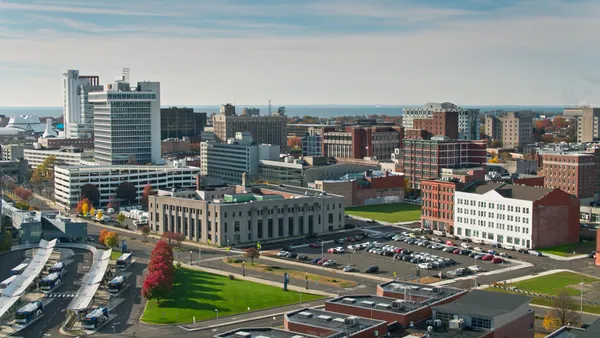Dive Brief:
- California saw its slowest growth rate in state history last year, with the state adding just under 187,000 new residents for a growth rate of 0.47%, according to data from the California Department of Finance. The slow growth, the state said, was due in part to a declining birth rate, lower student enrollment and a higher death rate among the Baby Boomer generation.
- Of the 10 largest cities in the state, Sacramento had the largest percentage gain in 2018 at 1.49%, or 7,400 residents. Bakersfield was the only other city with a growth rate higher than 1% among the state’s largest cities.
- Chico and Oroville each added more than 20% to their total populations. Meanwhile, the Camp Fire in Butte County destroyed more than 14,600 housing units and drove significant population change, displacing 83% of the population of Paradise.
Dive Insight:
The modest population growth makes Sacramento a boomtown compared to California’s coastal cities. Los Angeles (0.04% population growth), San Diego (0.4%), San Jose (0.02%) and San Francisco (0.3%) were all relatively stagnant, in part a reflection of their high housing prices. By contrast, small and mid-sized cities saw some of the largest growth rates.
For Sacramento, the growth comes as the city is working to achieve sustainability goals, especially around transportation. The city has said it wants to be the "ZEV Capital of California" by deploying 75,000 electric and zero-emission vehicles by 2025. Through a partnership with Volkswagen-backed Electrify America, the city has launched two electric car-sharing networks and is working on electric bus and shuttle routes.
The city has also promoted electric bikes and scooters (the Sacramento Bee reports that more people have used Jump e-bikes than are riding Uber in downtown Sacramento), and has even partnered with the app Miles to offer rewards for people who opt out of driving. It’s a bid to both meet its climate goals and reduce air pollution, which ranks among the worst in the nation.
The city’s 2035 General Plan, which laid out greenhouse gas emissions reduction targets, prioritizes smart development, including neighborhoods that prioritize walking and biking, broader use of solar energy and sustainable architectural design practices. That plan could help Sacramento manage population growth without hurting its climate change goals, a priority across the state.











